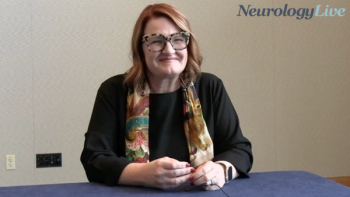
Restless Leg Syndrome Warrants More Attention, Expert Says
The restless leg syndrome expert spoke about the commonality of both pediatric and adult patients oftentimes misdiagnosed or undiagnosed with RLS.
Daniel Lee, MD
With current estimates suggesting that restless leg syndrome (RLS) affects about 10% of the population, the National Sleep Foundation suggests that 94% of patients are still either undiagnosed or misdiagnosed with RLS, a debilitating neurological condition.
Even though RLS is much more recognizable than it was a decade ago and we know more about the pathophysiology, challenges still exist like addressing misconceptions and augmentation.
To provide additional insight into RLS, a disorder that warrants more attention, NeurologyLive spoke with Daniel Lee, MD, medical director at Baptist Health Neurology and clinical professor at the University of Kentucky College of Medicine, in an interview.
NeurologyLive: Can you talk about restless leg syndrome and its diagnosis?
Daniel Lee, MD: Restless leg syndrome (RLS) is probably one of the most common sensory-motor neurological conditions that any clinician will ever encounter. It affects about 10% of Americans, but unfortunately, according to the National Sleep Foundation 94% of patients are still either undiagnosed or misdiagnosed with RLS.
Usually, we use the pneumonic URGE to make a diagnosis. According to the International Restless Leg Study Group Diagnostic Criteria, we summarize it with the pneumonic urges: U stands for urge to move, R stands for rest worsening the symptoms, G stands for get better when they move around, E stands for evening time is usually worse. Unfortunately, a lot of the patients when they suffer from RLS not only does it affect their sleep at night, but according to Johns Hopkins the REST study, the researchers found that those patients who suffer from RLS often complain about poor quality of life comparable to other chronic people obtaining medical conditions such as osteoarthritis, diabetes and depression.1
It reminds me of a 79-year-old lady that came to see me when I was practicing down in North Carolina. She was coming down from Washington, D.C. and at that time she said she had been suffering with RLS for about 30 years, and initially she paced the floor and was a little bit better, but after 10 years of suffering from RLS pacing the floors no longer helped her and she had to hit her leg or sometimes soak her feet in scalding hot water to get temporary relief, so it’s a very debilitating neurological condition.
Now, we know a little bit more about the pathophysiology of RLS. The Emory University group and David Wright have alluded to that dopamine dysfunction could be one of the reasons why patients suffer from RLS. Then, the John Hopkins group, Christopher Early, suggests that an iron transport problem may be one of the reasons why patients suffer from RLS and because of that, that’s why we often check with our patients when they complain about RLS whether they have an iron deficiency. We often check their ferritin levels and if their ferritin level is less than 50, we consider replacing the iron.
With regard to the dopamine dysfunction, now there are 4 medications that have been approved by the FDA as the first line of treatment, we have ropinirole, pramipexole and rotigotine, those are dopamine agonist medications, and the only non-dopaminergic medication that’s been approved by the FDA for the treatment of RLS is gabapentin enacarbil. All of them are considered as a first line treatment. You might say well why are we using non-dopaminergic medications when you just mentioned that dopamine dysfunction is the cause of RLS. The reason why non-dopaminergic medication is being utilized is because the longer we’ve been practicing sleep medicine, the patient that’s initially coming to us for RLS after being put on the dopamine agonist are experiencing symptoms earlier and earlier in the daytime and not only just involving the lower extremities, but now they start having it in the arms or the trunk and it's to the point that the symptoms are worse before the patients were ever treated and those are called augmentations. It’s one of the phenomena we’ve observed in patients being treated with dopaminergic medications and especially when patients that have been on a high dose of dopaminergic medication or have been exposed to dopaminergic medication for a prolonged period of time. And so, that’s why the International Restless Leg Study Group published a white paper suggesting that if physicians have to use a dopamine agonist medication to try to use the lowest possible dose that is effective in treating patients. The group also considers non-dopaminergic medications as a first line of treatment instead of exposing the patient with dopaminergic medication early on. We also find that those patients in the past have been treated with sinemet and in practice, there’s still quite a number of patients being treated with sinemet which is not an FDA approved treatment but is still out there and we've found that it's 75% consistent with what Richard Allen, PhD, at Johns Hopkins reported, that those patients are more likely to develop augmentation. Since sinemet is a short-acting dopaminergic medication, we found that when using short-acting dopamine agonists such as ropinirole and pramipexole patients are also more likely to develop augmentation as compared to the longer acting rotigotine patch.
Sometimes when a patient has been on a dopaminergic medication for a long period of time and develop an augmentation, they consider weening them off from dopaminergic medications by utilizing what we call cross-titration, starting a patient with a non-dopaminergic medication and then gradually when the symptoms get better, weening them off the dopamine agonist medication.
Right now in the laboratory, we’re studying other medications that is a combination medication to alleviate patients who have augmentation problems, but it’s still in clinical trials.
What's the best advice you can provide to general neurologists/primary care physicians?
DL: There are a couple of things for general neurologists or any physician caring for this population should know. First of all, some of the patients that have been drinking a lot of caffeinated drinks may consider coming off of caffeinated drinks or somebody that smokes, may be advised not to smoke, but we also need to look at the list of medications that might worsen the RLS and sometimes those medications used are selective serotonin reuptake inhibitors (SSRIs) or tricyclic medications or any medications blocking dopamine such as neuroleptic medications or anti pneumatic medications, and they certainly can worsen RLS. Patients can misconstrue as having augmentation and it can come off as though some of the latter medications may be helpful. We also recommend to people have regular exercise, but not 4 hours before bedtime. There is some non-pharmacologic treatments such as Relaxis, a gadget that patients put around their lower extremities to alleviate some of the symptoms too.
Are there any misconceptions that need to be addressed?
DL: I was just giving a lecture and among pediatricians many of them said that they’ve observed a lot of children misdiagnosed as having growing pains, and Art Walters, MD, of Vanderbilt, published a paper on that many patients misdiagnosed as having growing pain syndrome turn out to have RLS too—that certainly can be something to look at.
I just saw a patient this week and the patient was sent to me most likely having a peripheral vascular problem, but in peripheral vascular disease, usually patients when they ambulate they get worse, they’re walking a block and they start having the pain, having the symptoms, which is the complete opposite of RLS—walking and activity usually alleviate the symptoms. Some of the psychiatrists will say how can we discern akathisia compared to RLS, well, akathisia does not follow the circadian rhythm like the RLS does, so it is possible to discern those different types of conditions that oftentimes misconstrue.
Peripheral neuropathy is another disorder that patients are often misdiagnosed with, but it's commonly seen among diabetic patients. Those patients usually have tingling, numbness sensations and they fall into "stocking-glove" sensory deficit with temperature sensation and they also have absence reflex in the peripheral neuropathy. Usually peripheral neuropathy does not follow the circadian rhythm, but RLS does follow circadian rhythm and it’s usually worse in the evening or whenever patients are lying down, going to bed or sitting down to watch a movie with the family, and it’s the time that’s interfering with family life or sleep.
Transcript edited for clarity.
REFERENCE
1. Allen RR, Walters AS, Montplaisir J, et al. Restless legs syndrome prevalence and impact: REST general population study. JAMA Internal Medicine. 2005;165(11):1286-92. doi: 10.1001/archinte.165.11.1286.
Newsletter
Keep your finger on the pulse of neurology—subscribe to NeurologyLive for expert interviews, new data, and breakthrough treatment updates.


































